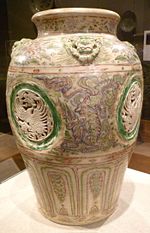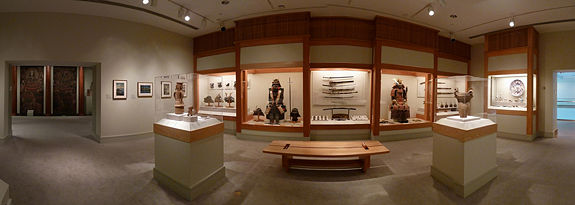Birmingham Museum of Art Asian collection
The Birmingham Museum of Art Asian collection is a major Birmingham Museum of Art collection of over 4,000 works spanning the Asian continent and dating from the neolithic period to modern works. The collection has long been considered the largest and most comprehensive of its kind in the Southeastern United States. Don Wood serves as the museum's Chief Curator and William M. Spencer III Curator of Asian Art.
As part of its mission to display a comprehensive range of artistic works, the museum's Asian art collection includes works from many periods representing the arts of China, Japan, Korea, India, Tibet and Southeast Asia.
History
A pair of Qing Dynasty ladies' shoes donated by the Progress Study Club were among the first artworks assembled when the Birmingham Museum of Art was established in 1951. Museum director Richard Howard donated his collection of Japanese prints in 1953. The collection grew in the late 1950s with the donation of Chinese lacquerware, Buddhist sculptures and a court robe from Cornelius Love of New York, New York during the museum's move into its current home in the Oscar Wells Memorial Building.
Ben Morton donated a group of Tang dynasty ceramics, including a remarkable horse sculpture in 1961. Belle Comer and Frances Oliver also made notable donations in the 1960s. A number of prehistoric Japanese artifacts was donated in 1971 by David Chase. The late 1970s saw the acquisition of two important collections of jade objects, one from former trustee William Spencer and another from the estate of John Meyer.
In 1972 collector Bruce Sullivan and others interested in cultivating appreciation for Asian art in Birmingham invited Cleveland Museum of Art director and Asian art expert Sherman E. Lee to visit and consult with them on the direction of the Museum's collection and of their own efforts. He strongly endorsed the creation of a Birmingham Asian Art Society and made a suggestion to put a focus on collecting Southeast Asian ceramics, fine examples of which were then on the market at accessible prices.
The Society was organized in 1975 and has since helped nurture the collection into one of international importance. In addition to the ceramics recommended by Lee, members of the society also purchased several contemporary Chinese paintings for the Museum in the 1970s and 80s. Besides acquisitions the society promotes appreciation of the collection by sponsoring visiting lecturers and special events and has established an endowment to support acquisitions and operations.
In 1979 the Collection was given new gallery space in the expanded museum. At the same time a dedicated Curator of Oriental Art, John Seto was hired. In 1982 three major touring exhibits of Asian art were scheduled to coincide with the Birmingham Festival of Arts 1982 Salute to Japan. Five exhibitions were mounted to celebrate the 1987 Salute to China, the same year that Wood arrived as the collection's second curator. Wood oversaw a major reinstallation of the Asian art galleries in 1988.
In 1993 the entire museum underwent a major expansion and renovation, resulting in another reinstallation of the Asian collection into seven new galleries on the upper floor.

Gifts in the 1980s and 1990s included a collection of rugs donated by Coleman Cooper in 1986, a collection of prints donated by the city of Maebashi, Japan in 1994, a collection of Chinese snuff bottles donated through the North Carolina Museum of Art, five volumes of Noh theater prints donated by Margaret Strickland in 1999. The same year a significant group of Indian and Southeast Asian sculptures was donated by Eivor and Alston Callahan, leading to the naming of the Indian Art gallery for them. The museum's Korean gallery was renovated in 2001.
Eighty pieces of blue and white porcelain from the 14th to 19th centuries were donated in 2002 by Thaddeus Crenshaw. The 80-piece Vetlessen Jade Collection is on long term loan from the Smithsonian Institution. Other important pieces have been donated by EBSCO Industries.
Throughout this time the Museum has made its own acquisitions of notable works of all kinds. A Lê Dynasty jar purchased in 2011, was declared the world's 9th most important public acquisition of that year by London's Apollo magazine.
The Chinese and Japanese galleries underwent a major reinstallation after the close of the 2007 "Pompeii: Tales from an Eruption" touring exhibition. They reopened on June 28, 2009 with many more pieces displayed in denser exhibition cabinets. The works were re-organized around four main themes rather than by chronology, providing insight into how technology, transportation, religion and artistic style were represented over the two and a half millennia during which works in the collection were produced.
Exhibitions
Organized by the BMA
- Chinese Paintings by Tseng Yu-Ho (1954)
- Japanese Ceramics (1967)
- Sumie by Sophie Gau-Lewis (1973)
- Ceramics by Toshiko Takeazu (1977)
- Contemporary Korean Ceramics (1982)
- Contemporary Chinese Paintings (1984)
- Ceramics: The Chinese Legacy (1984)
- Dancing Ink: Calligraphy by Wang Fangyu (1985)
- Landscape Painting in Contemporary China (1985)
- Dieties, Emperors, Ladies and Literati: Figure Painting of the Ming and Qing Dynasties (1987)
- Woodblock Prints by Kitaoka Fumio (1992)
- Van Gogh's Japanese Prints (1994)
- A New Vision: The Dr Aubrey C. Land Collection of Contemporary Japanese Prints (1995)
- Echizen: Eight Hundred Years of Japanese Stoneware (1996)
- A Golden Age: The Dr Roy T. Ward Collection of Japanese Prints (1996)
- The Elegant Brush: Korean Literati Paintings from the Collection of Dr Won-kyong Cho (1996)
- Brave Warriors and News from the West: Japanese Prints from the Collection of Colonel and Mrs Charles C. Bennett (1997)
- Images of the Floating World: Japanese Prints from the Birmingham Museum of Art (1998)
Touring exhibitions
- Chinese Ivories from the Smithsonian Institution (1957)
- Oriental Rugs from the J. J. Durrett Collection (1959)
- Indonesian Batiks from the Museum of Fine Arts, Little Rock (1960)
- Japanese Prints from the Lauren Rogers Museum of Art (1960)
- Near Eastern Art from the Metropolitan Museum of Fine Art (1961)
- Korean Monuments of Architecture and Sculpture (1961)
- The Painting of Persia and India (1963)
- Tōkaidō Prints: Adventures on the Road in Old Japan (1982)
- Japanese Paintings from the New Orleans Museum of Art (1982)
- Tang Gold and Silver from the Dayton Art Institute (1985)
- Chinese Cloisonne: The Clague Collection (1987)
- In Pursuit of the Dragon: Traditions and Transitions in Ming Dynasty Ceramics (1988)
- '"The Art of Wu Guanzhong (1989)
- Summoning of the Soul: Treasures from Ma Wangdui (1990)
- Kiyochika: Artist of Meiji Japan (1990)
- The First Emperor: Treasures from Ancient China (1996)
- Beyond the Tanabata Bridge: A Textile Journey in Japan (1994)
- Otsu-e from the Minneapolis Institute of Arts (1998)
Catalogs
- Seto, John H. (1988) Handbook of the Oriental Collection. Birmingham: Birmingham Museum of Art/EBSCO Media ISBN 0931394244
- Wood, Donald A. (2000) Asian Art in the Birmingham Museum of Art. Birmingham: Birmingham Museum of Art/Craftsman Printing ISBN 0931394465
References
- Huebner, Michael (June 21, 2009) "Birmingham Museum of Art Asian galleries reopens June 28 with makeover, rekindled pride." Birmingham News
External links
- Asian Art collection at artsbma.org
